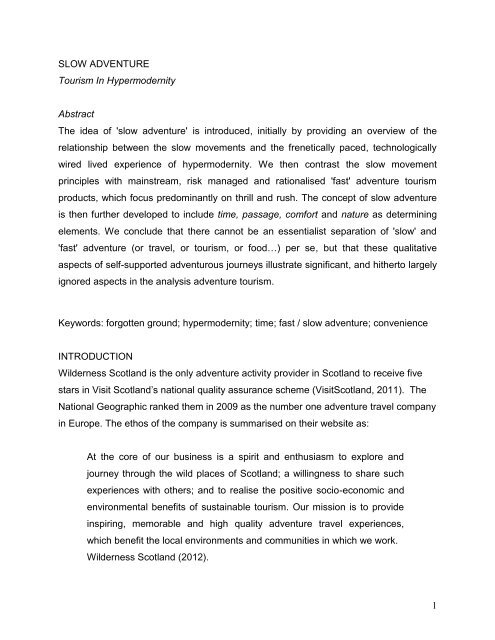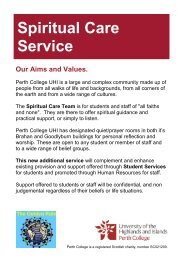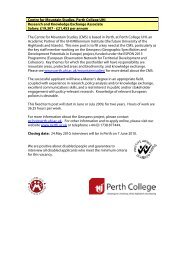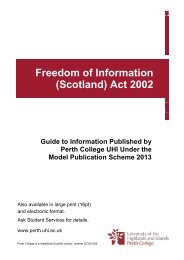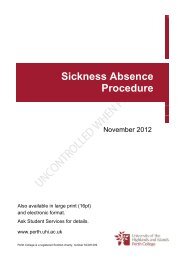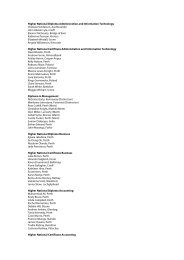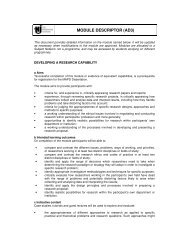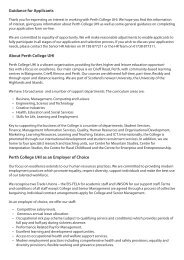1 SLOW ADVENTURE Tourism In Hypermodernity ... - Perth College
1 SLOW ADVENTURE Tourism In Hypermodernity ... - Perth College
1 SLOW ADVENTURE Tourism In Hypermodernity ... - Perth College
You also want an ePaper? Increase the reach of your titles
YUMPU automatically turns print PDFs into web optimized ePapers that Google loves.
<strong>SLOW</strong> <strong>ADVENTURE</strong><strong>Tourism</strong> <strong>In</strong> <strong>Hypermodernity</strong>AbstractThe idea of 'slow adventure' is introduced, initially by providing an overview of therelationship between the slow movements and the frenetically paced, technologicallywired lived experience of hypermodernity. We then contrast the slow movementprinciples with mainstream, risk managed and rationalised 'fast' adventure tourismproducts, which focus predominantly on thrill and rush. The concept of slow adventureis then further developed to include time, passage, comfort and nature as determiningelements. We conclude that there cannot be an essentialist separation of 'slow' and'fast' adventure (or travel, or tourism, or food…) per se, but that these qualitativeaspects of self-supported adventurous journeys illustrate significant, and hitherto largelyignored aspects in the analysis adventure tourism.Keywords: forgotten ground; hypermodernity; time; fast / slow adventure; convenienceINTRODUCTIONWilderness Scotland is the only adventure activity provider in Scotland to receive fivestars in Visit Scotland’s national quality assurance scheme (VisitScotland, 2011). TheNational Geographic ranked them in 2009 as the number one adventure travel companyin Europe. The ethos of the company is summarised on their website as:At the core of our business is a spirit and enthusiasm to explore andjourney through the wild places of Scotland; a willingness to share suchexperiences with others; and to realise the positive socio-economic andenvironmental benefits of sustainable tourism. Our mission is to provideinspiring, memorable and high quality adventure travel experiences,which benefit the local environments and communities in which we work.Wilderness Scotland (2012).1
It is apparent from the company’s marketing that the commodification of thrill is notcentral to their business model, and yet their ranking and status in the adventuretourism industry is of the highest order. It would appear then that Wilderness Scotlandhave, through a broader interpretation of the notion of adventure, been notablysuccessful in marketing to a particular audience which Weber refers to as ‘marginaladventure tourists’ (2001: 374) (i.e. not adrenaline junkies ) and what Walle (1997) hastermed insight seekers. <strong>In</strong> this paper, we wish to consider the concept of ‘slowadventure’ as a suitable label for these tourist experiences. The modern era hasallowed and promoted the expansion of tourism, via processes of rationalisation whichmanage time for economic gain, but also allow free time for the refreshment of labourand for consumption. Free time, therefore, often becomes an imagined opportunity for areconnection with romanticised notions of rich, meaningful experiences. <strong>In</strong>evitably,tourism and leisure have also been thoroughly colonised by capitalism, and often fail todeliver their promised rewards. The experiences are tightly managed, and, even for theadventure tourism consumer, often alienating.However, Scott Lash argued that a ‘second’ modernity has developed, in opposition toand yet in concert with the Enlightenment rationality of progress, order, homogeneityand cognition, and ushered-in a different (ir)rationality of uncertainty, transience,experiment, and the unknowable. These aspects of the second, or ‘other’ modernitycelebrate aspects of life that are central to the slow movements. As the pace of modernlife accelerates, and de-differentiation is accentuated, what is forgotten is the dimensionof what Lash (1999) has referred to as the ground; the ‘forgotten ground’. Slowadventures are in effect explorations of and reconnections with this ground: sensingplace, community, belonging, sociality, tradition, time and nature.Slow adventure, and slow movements in general, are in many ways a cultural response,attempting to recover modernity's forgotten ground against the backdrop ofhypermodernity, a term used by Paul Virilio (2000, 2004) and others to describe thelived experience of the accelerating pace of modern lives. <strong>In</strong> this paper we develop theconcept of slow adventure, initially by contrasting the slow movement ideas with the2
more mainstream, ‘fast’ packaged adventure experiences available in the marketplaceand then by considering its key dimensions; nature, time, passage, and comfort. Weconclude with an acknowledgement that there cannot be an essentialist separation of‘slow’ and ‘fast’ adventure (or travel, or food…) per se. Rather, these experiences arearraigned along a continuum and determined by qualitative, subjective, and temporalaspects, which allow degrees of remove and respite from the frenetic pace of the urbaneveryday in hypermodernity.The notion of departure is embedded within tourism as a transition from the everyday tothe extraordinary in a search for pleasure (Rojek and Urry 1997). Within the sphere ofadventure this notion is often framed as escapism; a quest for freedom or solitude or anescape attempt of sorts (Pigram & Jenkins, 2006; Schmidt & Little, 2007; Cohen andTaylor 1992) It must be recognised however that slow adventure is absolutely part ofhypermodernity, generated as a dialectical response to the frenetic, neurasthenicconditions of contemporary urban life. It is part of the forgotten ground. Much as Eliasand Dunning (1986) claimed that leisure and the quest for excitement is in effect apressure-release valve from rationalisation and control, so slow adventure provides anadjunct to the groundlessness and accelerating pace of hypermodernity.Whilst the prefix ‘slow’ seems currently to be almost ubiquitous in a variety ofcontemporary cultural realms, the term is used here as stimulus for the recognition of apeculiar paradox. Most adventures, particularly in the commercial arena, would beregarded as ‘fast’, encompassing as they do the intense, focused moments ofconveniently packaged excitement which fit neatly into busy urban lives. To speak of‘slow adventure’ at first seems at odds with the known in common concept of adventure.However, in this study we aim to demonstrate that there are adventure forms whichshare many of the core values attributed to other aspects of the slow movements,including; respect for quality over convenience, tradition, ‘authentic’ experience, theconnection between people and place, exploration, and extended time for rejuvenation,re-enchantment and reflection. We refocus attention on the exploratory origins ofadventure – linked with slow travel but also with the practice of dwelling and immersionin wild, natural places.3
<strong>SLOW</strong> <strong>ADVENTURE</strong> AND HYPERMODERNITY<strong>Hypermodernity</strong> increasingly celebrates and embraces flux and change and as such,both society and the individual can be viewed as enacting a continual metamorphosiswhere the space of our shared and personal values and meanings becomesfragmented, constrained and atomised. Liberation from the confines of the traditional,and the grounded and rooted practices of being and doing, has forced members ofindustrialised societies into an increasingly agitated and anxious state (Auge, 2008).<strong>In</strong>deed, this neurasthenic condition generated by the increasing sense of motion andpace in modernity was anticipated by Simmel’s essay Metropolis and Mental Life(Simmel 1971a) over 100 years ago, and continues unabated.Yet this is paradoxically set in contrast with the recognition that members of urbanindustrialisedsocieties are becoming more sedentary as the concomitant trend towardconvenience, packaged experiences and homes used as private technological leisurecentres intensifies. For many, movement, connection and exploration are beingsubsumed into the realm of the virtual where travel is instantaneous and no longerconfined by the old frontiers (see Auge, 2008, p. 61-93). Within hyper-modern societythere is an apparent sense of temporal and spatial transcendence that is manifestedthrough time-saving paraphernalia, communications technology and fast fashions, theprocesses of globalisation, the growth of entertainment and social media. At the sametime this may be conceived of as an enslavement:Doomed to inertia, the inactive being transfers his natural capacities formovement and displacement to probes and scanners which instantaneouslyinform him about a remote reality, to the detriment of his own faculties ofapprehension of the real… Having been first mobile, then motorised, man willthus become motile, deliberately limiting his body’s area of influence to a fewgestures, a few impulses like channel surfing. (Virillio, 1997, p. 11, 16).4
This temporo-spatial pressure is further complicated by the sense that the very pace ofour lives is outrunning us, leaving us constantly short of time as time itself seems toaccelerate (Auge, 2008). Little time is available for individuals to anchor themselvesontologically with places, narratives and history which confer meaning (Lipovetsky andCharles, 2005; Virillio 1989). Castells (1996) suggests that the ‘ground’ ofhypermodernity is ever-shifting, and that simultaneously the subject is lost in a world ofdiscontinuity; connected with but confined by complex social networks of humanconsumption and communication which are extending and accelerating into more andmore social spheres (Lipovetsky and Charles, 2005).Against this pessimistic portrayal of hypermodernity, Honore (2004) has documented anemerging global phenomenon; that of the ‘slowness movements’ which appear to begrowing in response to, if not directly in confrontation with, the speeding up of society.This counter-cultural wave, manifesting itself in forms of slow food, slow cities, slowtravel, slow tourism, slow learning, is, according to Honore, evidence of a widespreadperception that a fundamental slowing down is required if we are to focus on quality andmeaning in our lives as opposed to convenience and efficiency (Honore 2004). <strong>In</strong>alignment with these value driven choices we propose that slow movement adherentsare performing a lived resistance to hypermodernity. The movements are characterisedby a valorisation of heritage, time, tradition and authenticity, and our conceptualisationof slow adventure is no different.The attraction of the slow movements may thus lie in their ideological (and embodied)opposition to many of the conditions of hypermodernity. These movements celebrateand emphasise origins, history, culture and place. For example, in the Slow Foodmovement local delicacies are renowned for their central role in local life, traditionalpractice and culture. Slow, rather than fast processes of production (and consumption)are important. Effort and extended time taken in both production and consumptionconfers quality and is set in opposition to the rationalised, effort-saving and time-savingprocesses of fast / convenient food systems. Slow food is of the land, of the people and5
seasonal (of time) and its production and consumption reflects this and is in essenceparticipatory, and of the ‘ground’.There is also an ambiguity; slow food characteristics can vary due to the people, soils,weather and time of consumption. <strong>In</strong>deed, time, inevitably, is the core strand whichunderpins the slow movements. Time lost through over-committed lives translates astime invested (found) in production, in connecting with place, in being with others, inshared enjoyment and communitas; it is time which allows meaning to be generatedand experiences and memories to coalesce. Here we may see the link between thisconcept and how the ideas of slow adventure are aligned.Adventure tourism and slow travelPut simply, the concept of slow travel is based on a richer appreciation of the journey asan experiential dimension rather than the chore of getting to a destination. <strong>In</strong> this sense,the journey is the holiday. Gardner argues that ‘speed destroys the connection with thelandscape’ and space-time compression accelerating in hypermodernity means thatjourneys often lose their significance as part of the tourist experience in many contexts(2009, p.13). If the journey is slow, takes time, and requires effort, the tension ofseparation, the distance between the familiar and the exotic is more directlyexperienced through the process of travel from one place to another and through thelinear transit of routes (Tuan 2003). Peters (2006, p.1) introduces the subjectiverelationship between travel, temporality and perception by stating that ‘travel not onlytakes time, but it also makes time’. By this he means that it is as though the intersticesbetween the nodal points of arrival and departure create and delineate a temporalspace, a kind of micro-rupture from our everyday metronomic routines. Thus ‘the tripconstitutes... a place where time stands still or is reversed into a utopian space offreedom, abundance and transparency’ (Curtis and Pajaczkowska, 1994, p.199).The apparently paradoxical notion of slow adventure also draws upon the recent workon slow travel and tourism by Dickinson & Lumsdon (2010), which itself builds in partupon the notion of mobility (Urry, 2000; 2002; 2007), and the ideologies of the slow6
movements to present a new analytical framework for adventure tourism research. Forthe slow adventurer, the geography delineating the realms of home and holidayexpands, no longer as a problem requiring the speediest execution, but rather as a fieldof opportunity for a particular leisure and tourism experience to unfold.Dickenson & Lumsdon (2010, p.88) state that the “embodied sense of being there,physically coping with the locality” is a central experiential aspect of slow travel thatleads to the formation of significant memories and narratives which often relate to theadventurous moments of such journeys. Yet they pay little attention to the leisure andtourism form ‘adventure’. This may in part rest upon the aforementioned paradox: thatcombining the term ‘slow’ with the term ‘adventure,’ may seem odd when popularrepresentations and dominant discourses focus narrowly upon speed, rush and thrill(Cater, 2006; Buckley 2011).Slow adventures are imbued with a sense of the explorer-ethic and with a hithertoconflicting ecosophical sense of comfortably dwelling in wild places in recognition thatsuch places are (or were once) in fact our home (Naess, 1993; Varley and Medway,2010). The ‘conflict’ arises from ideologies and narratives drawn from the era ofexploitative exploration under colonial capitalism, set against more contemporarynotions of belonging to the wild (Naess, 1993). Trends which might evidence thepopularity of such adventure tourism forms include the massive rise in prime timetelevision programmes celebrating pristine environments, indigenous cultures, bushcraft and survival skills.The formerly dominant definitions of the term adventure (see Priest, 1990; Ewert, 1989;Mortlock, 1984; Quinn 1990) steer closer towards ‘frontier’ and ‘mis-‘ adventure, yet theAdventure Travel Trade Association states that:Today’s adventure traveller seeks experiences beyond high-adrenaline sports.Adventure provides a mix of activities that enable authentic, un-manufacturedexperiences’7
(Adventure Travel Trade Association, 2009).Risk theories in the literature on adventure (Mortlock, 1984; Martin & Priest, 1986;Ewert, 1989; Priest & Bunting, 1993; Morgan, 2000; Lewis, 2000, 2004; Keiwa, 2002)encapsulate the adventure motive as a desire for borderline experiences occupying thethreshold between catastrophe and adventure. Such representations, with their almostfatalistic proximity to disaster seem essentialist and elitist, and intuitively are at oddswith the motives of many contemporary adventure travellers and tourists. The bungeejump, zip wires, white water rafting trips and abseiling sessions all squeeze the highestthrill quota into the tightest package (Cloke and Perkins, 2002; Cater, 2006), but ignorethe wider experiential context.<strong>In</strong> contrast, Walle’s (1997) ‘insight model’ confronted the dominant focus on risk takingbehaviour with the proposition that risk is merely the by-product of a more importantand overarching motivation for insight and knowledge in wild places and that thetourism industry can benefit by developing products for this market. Walle’s articledraws upon the rich legacy of American writers and thinkers such as John Muir, RalphWaldo Emerson, and Henry David Thoreau who have drawn philosophical and ethicalinspiration from their experiences of nature (ibid 1997). The key example provided byWalle, that of fly fishing, fails to satisfy many of the accepted terms of reference fortheorists of ‘risk and rush’ adventure . If, however, Walle’s ideas are expanded aroundfly fishing to include self supported travel, navigation, wild camping, the exploration ofnew rivers or lakes, particularly in remote, unpopulated and ‘wild’ locations, then thejourney to the location, as well as the actual fishing, start to take on the mantle of whatwe term ‘slow adventure’.Weber (2001, p. 364) makes the point that adventure is intrinsically linked withexploration, yet the importance of location, sense of place and travel are overlooked inthe delivery of many packaged adventure tourism products. She goes on to articulatethat various journeys, particularly overland travel in ‘peripheral countries’ (Ibid 2001, p.364-367), whilst being particularly adventurous, are not part of the common language of8
adventure. It is here again that the notion of ‘slow’ adventure, as part of a spectrum,provides a conceptual framework within which to locate and explore those aspects ofthis form of tourism that foregrounds a sense of journeying, exploration, and placerelationship.The concept of slow adventure is thus positioned to augment otherspectrums such as hard / soft adventure (Sung, Morrison and O’Leary, 2000;Swarbrooke et al., 2003; Beedie and Hudson, 2003; Dodds, 2006; Doyle et al., 2010)and deep / shallow adventure (Varley 2006, 2011).<strong>In</strong> Easton and Warburton’s (2010) market report on adventure tourism in Scotland, theyclarify the need for a definition of adventure tourism which moves beyond a focus onadventure sports (2010, p. 5) and they offer a redress to the overly narrow focus ofsome researchers and marketers who have fixated on risk and thrill; a view echoed byothers including Walle (1997), Weber (2001) and Varley (2006). The obsession withintense, exciting moments can be seen to be a myopic focus on what might for someseem to be the most vital organ in the body of adventure, but this nevertheless fails tocapture the lived experience of extended adventurous journeys in the wild. Easton andWarburton (2010) go on to highlight research by the Adventure Travel TradeAssociation, which identified seven elements that represented the essence of adventuretourism:Transformation: discovery of the ‘real me’.Discovery: the end result of exploration, and a prize for stepping out ofthe comfort zone.Deep Appreciation: appreciating something bigger, something timelessand more than our everyday encounters.Engagement: moving beyond a passive encounter to something that isactive, engaging with people from different backgrounds, cultures andworld views.Web of Life: seeing ourselves as part of an interconnected network ofnature.The Real Thing: something which can only truly be experienced by being9
there.Legacy: passing on the stories, ideas and beliefs.(Easton and Warburton, 2010, p. 16)Clearly, each of these components requires a considerable commitment in terms ofparticipant time, and a willingness to let go; to allow the immersive process of being in anatural environment to unfold. Thus while extended duration and a gradual pace arecore ingredients of slow adventure, so too is the subjectivity of temporality; the feeling oftime. The concept of slow adventure will initially be defined by an examination of itsimagined opposite: ‘fast-adventure’, below.‘Fast’ adventureThe roots of the commodified form ‘fast adventure’ are deeply woven into the historyand psyche of modernity through the ideology, narratives and glorification of an‘adventure mentality’ (Nerlich, 1987) via fairy tales and accounts of heroic deeds. Laterthe adventure forms, already recognised as a useful aspect of capitalist exploitation,became training and education ‘products’ and, later, marketed tourist experiences. Theensuing rationalisation and commodification of adventure into adventure tourism(Varley, 2006), marked the beginning of a new epoch as such, where the romanticpromise of adventure was brought a step closer to the masses through an increasinglyfocused range of exciting holiday activities. The rationalising logic of ‘McDonaldization’(Ritzer, 1993) has subsumed the notion of adventure within the market place, whereconvenience, predictability and comfort are paramount. The marketplace has in shortdistilled the story of adventure down to its climactic moment and at the same timefiltered out its slow, uncomfortable and less attractive aspects. As such, these capsuleadventures become decontextualised from their broader narratives of journey andexploration and dislocated both from the environmental context and the holistic socialnature of the experience. The resulting “adventure in a bun… disassociate[s] peoplefrom their experience of community and place” (Loynes, 1998, p.35) similar to the waysin which fast food is conveniently removed from its origins as a rationalised melange of10
anonymised ingredients, (in contrast to slow food, which is a celebration of provenance,tradition and time).The carefully marketed images of physically attractive bodies and textually mediateddiscourses on television and in adventure marketing communications also endow theperformances of the fast adventurers with social significance and value. Fast adventurethus bestows an identity label, signifiers of cultural capital and social status for sale(Beedie and Hudson, 2003; Cloke & Perkins, 2002). Such occurances are, accordingto Moores (2000, p. 40) ‘a distinctive feature of contemporary society, existing associally organised communicative and interpretive practices intersecting with andstructuring people’s everyday worlds’. As such it is possible to see most forms of ‘fastadventure’ as belonging to the world of everyday consumer culture (Chaney, 2002)despite their spectacular qualities.Best’s (1989) work on the society of the spectacle can be applied to further articulatethe notion of fast adventure, where showmanship, voyeurism, extreme sports channels,sponsored ‘heroes’ and the staging and marketing of the ‘wow moment’ (see Cloke &Perkins, 2002) all play their part. This spectacle is given credence through theprocesses of 'post-mass tourism' (Urry, 1990) whereby fast adventure, as a commodity,is viewed as a badge of honour to be acquired, promising novelty, status, identity andexcitement:Participants engaging in commercial adventurous activity primarilyseek fear and thrills. The most successful adventure tourismoperators are those that have reduced their actual risk levels whilsteffectively commodifying the thrills within.(Cater, 2006, p. 317)Thus fast adventure, as a product of cash-rich, time-poor consumer society,when linked to the march of the hypermodern condition can be viewed as a11
part of the fabric of the everyday world of consumerism and, for many,ingredients in off-the-shelf identity construction tactics.Slow adventureWhilst the rationalisation of excitement is no doubt a desirable selling point for thecommercial operator, it is not the only source of competitive advantage in the adventuretourism industry. We propose that the qualities of slow adventure include all elements ofthe journey; the joys and hardships of outdoor living, self propelled travel andassociated physical engagement with the natural environment over time. These‘qualities’ may be summarised as: time, nature, passage and comfort. They are totallyinterdependent and deliberately malleable.‘Time’ is inevitably an important experiential component, and the awareness of timepassing during outdoor journeys is felt during the ‘passage’ (see below) of the journeyitself, and via natural change such as light and dark, tides and weather. <strong>In</strong> slowadventure, time does not merely pass, but is felt, in bodily rhythms of tiredness, sleep,wakefulness, and effort. For example, the perception of time via the dropping of the sunis corporeally evident as winds rise, the air becomes cold and shadows lengthen.Moreover, the significance of time is woven into the landscape as history, heritage,tradition, and origin (<strong>In</strong>gold 1993). This experiencing of a transient reality, a travel timeor time-out-of-time is infused with the notion of recapturing lost time, of ‘making time’(Peters 2006) and it is precisely this which captures the nuance of slow that wepropose.The effects of ‘Nature’ are acute in slow adventures, due to the extended period ofexposure. If we explore these adumbrative spaces we find the slow shivering belays onfrozen ice ledges; basking in the sun on rocks worn smooth by glacial erosion; theunfolding of natural expanses and wide skies, feet sinking into peat bogs; cooking inwild mountain corries; encounters with wildlife, struggling with tents in rain and wind;sleeping in and with the wild. It is this direct engagement with natural forces whichinsists that participants envelop themselves in their environment; surrender to it, even.12
Further, natural encounters with plants, animals and geological features can provide astory set in time and in a particular environment.Similarly, the term ‘passage’ refers not only to the physical journeying through aphysical landscape, (as opposed to the passage over the landscape of the passenger)but is also a journey of change and transformation, which takes time. ‘Passage’encompasses the navigation of self through time and space; the crossing of bordersand natural obstacles; moving toward horizons and the retrospective gaze to where thetraveller has come from. Tuan (2003, p. 54) suggests that ‘human lives are a dialecticalmovement between shelter and venture, attachment and freedom’. Between theidentifiable events or touristic highlights, which the literature focuses upon, the slowadventurer’s day unfolds in quiet periods of self propelled travel, autonomous humanpowered travel which may lead to boredom, day dreaming and trance-like lapses of selfawareness. This is the journey to / of elsewhere, and the slow adventure tourist carriesonly the basic material requisites for survival (food, shelter, navigational aids etc.)usually by their own physical effort.It is the very linearity and gradual passage and progression which contrasts with thespasmodic, frenetic virtual meta-city described by Virilio and Auge. The mobilities ofslow adventure unravel the ‘discontinuity and interdict’ of the worldwide metropolis(Auge, 2008, p. xiii) and may be considered to enhance the apparent effects of ‘timestretching’. The relationship between the body, the journey and immersion in naturaltime offers both corporeal and geographical evidence of passage, suggesting thedecompression of hypermodern time. This effect may eventually then allow asynchronisation of natural and personal rhythms. As such, time itself is, from aqualitative perspective, regained, re-felt and re-cognised, perhaps as a recovery of theforgotten aspect of child-experienced-time. <strong>In</strong> part that is a playful notion of day-dreamtimewhere the mind can wander freely. Passage, then, is a function of time, embeddedin nature, and a growing comfort in the process of the journey.13
‘Comfort’ equally has a number of meanings in the context of slow adventure. Firstly,there is the process of becoming comfortable with the challenges presented by thejourney (sustained effort for example). <strong>In</strong>deed, blisters, sores, sunburn, aches and painswould initially be framed as dis-comfort, and at odds with the usual tourist product. Yetthe journey becomes inscribed upon the adventurer’s body. <strong>In</strong> addition, comfort may bederived from a re-connection with place, tradition and history (linked to time). Thetraditional, rural life, imagined as slow, rich and meaningful can become a ‘refuge’landscape; a place to escape to. The spiritual or transcendental dimension of ruraltourism (Sharpley & Jepson, 2011) can be applied to the wilder landscapes ofadventure through the extension of a notion of slow interaction. Within this extension,the departure from the speed of the metropolis (Virilio, 1990) to the comfortableparameters of a vernacular language (Alexander, 1979) and indigenous practices(Mc<strong>In</strong>tosh, 2001) are taken a step further into an almost primitive condition of survival.Whilst inescapably framed by our cultural perspectives, such experiences are none-thelesspre-modern in essence and to an extent pre-socialised in their rawness.Slow adventure might therefore be presented as an escape attempt, beyond thenostalgia of idyllic rurality, but also as a recovery of the forgotten ground (Lash, 1999),remembering less alienated ways of being, and an embrace of the messy, contingentand variable character of that ground. The world’s wild places, particularly those thatrequire extended journeys to encounter them, offer a different reality for many and maybe actively or sub-consciously pursued by some adventurers as a refuge, or therapeuticspace that is in contrast to the fragmented, accelerating, mediated experience of thehypermodern subject.Effectively, time, nature, passage and comfort promote the sense of resistance tohypermodern conditions of lightness and speed, and offer the opportunity to dwell andconnect with places lived in and passed through (Obrador-pons, 2003). Walton (2009)proposes that ‘fast tourism’ distances the tourist from the original motivations andvalues of discovery, learning, exploration and spirituality, and suggests insights intopotential motives of the slow adventure tourist. We would go further, proposing that fast14
adventure is in effect an example of the time-space compression characteristic ofhypermodernity manifested in the marketplace, in which one can circumvent the messy‘ground’ of the slow adventure, and cut straight to the action. <strong>In</strong> contrast it is themessiness and discomfort of weather, the effort of load carrying, heat, boredom, damp,cold, - over extended periods, which must often be endured in slow adventures such asexpeditions, multi-day treks and kayak journeys and which comprise the experientialcontext.The liminal potentialities of tourism are steadily intensified in slow adventure via theeffort of sustained action which is attuned and responsive to the natural setting (Varley2011). These ‘liminal’ elements of the journey may be felt as the adventure touristshoulders the weight of a rucsac and passes into a wilderness area, or as;The kayakers move from the land to the sea and from comfort to hardship, fromsecurity to uncertainty, passivity to commitment, and from action … to totalbodily/sensual immersion.Varley, 2011Any adventurous journey is to some extent an act of disruption, via departure,discomfort, time away from home, the everyday of the journey, and then the return. Theliminal state marks a separation from the mundane regimes and rhythms of our life(Curtis and Pajaczkowska, 1994; Varley, 2011) and instead requires surrender to theregimes and rhythms of the natural environment. <strong>In</strong> the case of slow adventure thisexperiential phenomenon is accentuated by the real or perceived risks. Acircumnavigation of a tidal island by sea kayak exposes the paddler to a diurnal rhythmmeasured by the arc of the sun and the pull of the moon in a natural world in which thekayaker is suspended. As such, the lunar cycle is experienced through the flows andebbs of the tide. The kayaker’s journey is dependent upon both a rational andexperiential understanding of tidal flows as well as the indigenous knowledges abouthow the localised and particular manifestations of those forces may make stretches ofcoast impassable and potentially lethal at certain times of the tide. Likewise the15
mountaineer’s safety is dependent upon knowledge of the daily cycle of freeze andthaw. Ascent attempts must begin not with the rising of the sun, but shortly aftermidnight if participants are to avoid the icefall, avalanche, cornice collapse, and rockfallassociated with melt-freeze metamorphosis (Houston & Cosley, 2004, p. 31-51). Thesetemporal flows are experienced sensually, through the dream-like trudge across amoonlight expanse of frozen sasstrugi, the changing texture and sound of the nevecrunching underfoot or the freezing katabatic winds surging before the peaks appear ina glow of refracted light. The associated fusion of mind, body and environment throughthese forms of active, extended immersion may be felt as a deep sense of enjoyment,satisfaction and creative accomplishment (Csikszentmihalyi, 1975; Boniface, 2000;Hardy, 2003).Whilst fast adventure can be experienced by the tourist almost on a whim; for exampleas a half-day activity, a ‘multi-activity taster week’ or as part of a wider holidayexperience, slow adventure requires a serious commitment of both time and energy.<strong>In</strong>deed, commitment, uncertainty, natural hazards, navigation, transit, remoteness andself sufficiency are all necessary ingredients of slow adventure which in combinationimpact the tourist’s spatial and temporal perceptions even to varying degrees in thecommercial service-scape. <strong>In</strong> addition, when boredom, hunger, anxiety and physicaldiscomfort take hold, the experience is not easily exchangable for a more pleasing,accessible commodity. Thus while the notion of escapism and freedom may well bethemes of slow adventure (and of tourism in general), so too in slow adventure is theparadoxical notion of inescapability and commitment. <strong>In</strong> this sense the journeying ofslow adventure assumes a work-like aspect quite distinct from many other forms oftourism. Here, life is experienced as an embodied journey where dualisms of work andleisure, travel and residency, attachment and freedom become blurred.It is in this light that the slow adventurer is perhaps, through their extended inhabitationof an ‘extreme’ or ‘wild’ environment, establishing a newly territorialised everyday. Here16
all activity, however mundane, becomes unusually significant in its essential simplicityand necessity. Routines such as the erecting of tents, the packing of gear, collectingwater, cooking, all take on a deeper significance as part of the whole unfolding processof daily life on the journey.CONCLUSIONSThe ideas which make up the concept of slow adventure also have a significance for awider consideration of tourism. <strong>Tourism</strong> experiences harbor tremendous potential for arecovery of our ‘forgotten ground’, and indeed the expectation is that some of themarginal, contingent elements missing from hypermodern living might be recoveredwhen we stay away from home for a while. Thus, much of what constitutes tourism is infact the essence of the forgotten ground; the potential for less constrained behavior, fordark or intense experience, for discomfort and effort, for contact with exotic others wholive differently and operate other codes and rules. It is, after all, the variable quality ofhuman experience, in service encounters and the promise of difference and explorationwhich provides our stories, feeds our taste for the unknown, and keeps us coming backfor more.Slow adventures are clearly, in the eyes of the protagonists, worth the effort. There is astark contrast between the surroundings of opulence, comfort and luxury of a holiday ina managed resort with that of the freezing cold of a wilderness expedition or the lungbusting,exhausting plod of the Himalayan trek. <strong>In</strong> such endeavours there is an evidentinvestment of time, bodily effort, a sacrifice of modern comfort and a commitment to thejourney that suggests that rewards of particular personal significance may be a centralmotivation rather than the quest for conveniently packaged and accessed ‘intenseexperiences’. The proposition then is not that slow adventure is any more or lessauthentic or adventurous than other tourist activities, but that its protagonists may beparticularly concerned and driven by the idea of pursuing their own existential projectson their own terms. They invest effort in the journey and in doing so push against thetendencies toward the technologically-enabled sedentariness of the hypermodern erasuggested by Virillio. Whilst slow adventure journeys might at times be structured by17
enabled and dependent upon the technologies of the modern world, there is withinthem, a noticeable stepping away from the project of efficiency and speed. The closelymanaged experience is replaced by a focus on the particular, variable and localisedaspects of place and the method of exploration is the inverse of efficient; it isnecessarily ‘slow’. Counter-culture movements, such as slow food, are seen by authorssuch as Nilsson, Svärd, Widarsson and Wirell (2007) to be expressions of a stance thatvalues place-based relationships, local distinctiveness and process overhomogenisation and efficiency.But all of this is relative; most ‘slow’ adventure tourism products will have elements ofrationalisation, predictability and control. The fast-slow comparison is not a divide, but aspectrum of tourist possibilities and products. We cannot claim that slow adventure is inany sense an absolute standard with which to segment the tourism industry. Rather,slow adventure is a concept, which, like other elements of the slow movement, couldultimately attract some quality standards and assurances (and therefore to some extentbecome more rationalised).We use the cross-cutting planes of time, nature, passage and comfort which form a webof ideas connecting and dividing the dialectic between ‘fast’ and ‘slow’ adventure anddistinguishing slow adventure from slow travel / tourism. Time in this sense alsoencompasses the ‘decompression’ potential of slow adventure – journeys unfold athuman pace, meals take time to prepare; time is spent directly in the effort of journeyingand living. Memories may be created during the journey, but they may also be reconnectedwith. Characteristic of the fast adventure products is the snapshot photo soldback to the participant; tangible evidence of momentary achievement. Slow adventuresmight take photos along the way too, but there may also be new bodily adaptations,blisters, subjective understandings and new relationships to the world as prized effects.Nature, of course, has its own time frame, and the slow adventurer must attunethemselves to this phenomenon. For fast adventure, the vagaries of nature are oftenmanaged-out; the time-pressured consumer cannot wait for rivers to rise for their rafting18
trip, so instead, dam-release timings are adhered to; climbing walls are built indoors inorder that climbing can take place regardless of the weather and so forth. <strong>In</strong> slowadventures, nature offers an inescapable contrast to the manageable urban setting.Clothes get wet with sweat, rain, river or seawater, whilst winds or snow can makecrossings impossible and tents collapse. The natural aspect of slow adventuresintersects with the other themes and simultaneously confronts the rationalisingtendencies of modernity.The concept of passage is also an important, deliberately soft construct. Passage,clearly, encompasses the effort made in journeying, but also includes some contrasts.<strong>In</strong> slow adventure the tourist is an active traveller, not a passive passenger; people,nature, time and discomfort are to be coped-with, endured, enjoyed; effort is required,as is commitment. But the term passage also suggests the possibility formetamorphosis; a transcendent potential not unlike that suggested by Walle (1997).This metamorphosis may lead to additional qualities of the ‘passage’ which are closelyinterwoven with the fourth concept, comfort; it may lead to the participant feeling asense of heftedness to the land, river or sea – to momentary dwelling and what Simmel(1971b) has suggested is the ‘unconditional presentness’ of the adventure; being there.It is here that we propose the journeys of slow adventure differentiate themselves in thatthey liberate tourists from the confines of rational time but also return the traveller to theground. Auge’s (2008) most pessimistic portrayals of modernity present the darkdownside of our mobility where the global-city with a standardised, anonymous centre,grinds down local distinctiveness, creates insecurity, decentres the individual in a worldof discontinuity. It is against this backdrop that recreation and tourism assumes animportant role in bringing people together in activities where a sense of belonging,emotional commonality and communitas are experienced (Wheaton, 2004; Robinson,2008).The distillation of a single element of the adventure experience into a marketableproduct is perhaps characteristic of the progress of modernity. With clear parallels withother slowness movements, the slow adventure is therefore set up as a contrast with19
the tightly commodified, packaged ‘fast adventure’ archetype of the bungee jump or thetwo hour rafting trip. Slow adventure’s depth and complexity is related to its historicalfoundations in exploration and nomadism, as well as its four key constituents of time,nature, passage and comfort. It is proposed that this concept will expand and illuminatethe areas highlighted and alluded to by Easton and Warburton (2010) and provide alanguage with which to better apprehend the tourist’s experiences and motivations. Theidea provides insight, not just for the tourism industry, but also for policy makersfocused on health and well-being agendas and social scientists exploring the reflexiveresponses to the disenchanting and alienating conditions of hypermodernity.20
REFERENCESEaston, P. & C. Warburton (2010) Adventure <strong>Tourism</strong> Scotland: Market Analysis Reportfor The <strong>Tourism</strong> <strong>In</strong>novation Group. Retrieved 1 July, 2012, from Wild Scotland website:http://wild-scotland.org.uk/wp-content/uploads/2010/12/TIG-report.pdfAlexander, C. (1979) The Timeless Way of Building. New York: Oxford University Press.Auge, M. (2008) 2nd ed. Trans. J. Howe. Non-Places: An <strong>In</strong>troduction toSupermodernity. London: Verso.Beedie, P. and Hudson S. (2003) Emergence of mountain-based adventure tourism.Annals of <strong>Tourism</strong> Research Volume 30, (3,) (625-643)Best, S. (1989) The commodification of reality and the reality of commodification: JeanBaudrillard and post-modernism. Current Perspectives in Social Theory 9, 23-51Boniface, M. (2000) Towards an understanding of flow and other positive experiencephenomena within outdoor and adventurous activities. Journal of Adventure Educationand Outdoor Learning, 1 (1) 55-68Buckley, R. (2011) Rush as a key motivation in skilled adventure tourism: Resolving therisk recreation paradox. <strong>Tourism</strong> Management 33, (4), 961-970Castells, M. (1996) The Rise of the Network Society (The <strong>In</strong>formation Age: Economy,Society and Culture, Volume 1). Malden, MA: Blackwell Publishers.Cater, C. L. (2006) Playing with risk? participant perceptions of risk and managementimplications in adventure tourism. <strong>Tourism</strong> Management 27, (2), 317-325Chaney, D. (2002) Cultural change and everyday life. Hampshire: Palgrave.21
Cloke, P. & Perkins, H. C., (2002) Commodification and Adventure in New Zealand<strong>Tourism</strong>. Current Issues in <strong>Tourism</strong>, 5(6), 521-549.Cohen, S. & Taylor, L. (1992) Escape Attempts: The Theory and Practice of Resistanceto Everyday Life, London: Routledge.Csikszentmihalyi, M. (1975) Beyond boredom and anxiety. London: Jossey-BassPublishersCurtis, B., & Pajaczkowska, C. (1994) ‘Getting there: travel, time and narrative’. <strong>In</strong>Robertson, G., Mash, M., Tickner, L., Bird, J., Curtis, B., & Putnam, T. (eds), Travellers’Tales: Narratives of home and displacement. Abingdon, Oxon: Routledge (199-215).Dickinson, J. & Lumsdon, L. (2010) Slow Travel and <strong>Tourism</strong>. London: EarthscanDodds, R.(2006) Report for Caribbean Soft Adventure Study. Caribbean RegionalSustainable <strong>Tourism</strong> Development Programme.Doyle, C., Duverger, P., Heyniger, C., Lamoureux, K., Martin, N., Schneider, P., Stowell,S. (2010) Adventure <strong>Tourism</strong> Market Report. Retrieved 20 June, 2012, from theAdventure Travel Association website: http://www.adventuretravelnews.com/justreleased-adventure-tourism-market-reportEaston, P. & Warburton, C. (2010) Adventure <strong>Tourism</strong> in Scotland: Market AnalysisReport for The <strong>Tourism</strong> <strong>In</strong>novation Group. Retrieved 28 June, 2012, from the WildScotland website: http://wild-scotland.org.uk/wp-content/uploads/2010/12/TIG-report.pdfElias, N. and Dunning, E. (1986) ‘The Quest for Excitement in Leisure’, in Sport andLeisure in the Civilising Process London, Blackwell22
Ewert, A. 1989 Outdoor Adventure Pursuits: Foundations, Models and Theories.Columbus OH: Publishing HorizonsGardner, N. (2009) A manifesto for slow travel. Hidden Europe Magazine 25, 10-14Hardy, D. (2003) The rationalisation of the irrational: Conflicts between rock climbingculture and dominant value systems in society in B. Humberstone, H. Brown & K.Richards (eds) Whose journeys? The outdoors and adventure as social and culturalphenomena. Barrow-in-Furness: The institute of Outdoor Learning, 173-186Honoré, C. (2004) <strong>In</strong> Praise of Slowness. How a Worldwide Movement is Challengingthe Cult of Speed. New York: HarperCollins.Houston, M. & Cosley, K. (2004) Alpine Climbing: Techniques to Take You Higher.USA: Mountaineers Books<strong>In</strong>gold, T. (1993) The temporality of the landscape. World Archaeology 25, (152–71)Lash, S. (1999) Another Modernity A Different Rationality, London, BlackwellLewis, N. (2000). The climbing body, Nature and the experience of modernity. Body &Society, 6(3-4), 58-80.Lipovetsky, G. and Charles, S. (2005) Hypermodern Times, Cambridge: Polity Press.Loynes, C. (1998) Adventure in a Bun. Journal of Experiential Education, 21 (35-39)Harrins & R. Park (eds) Play, games and sport in cultural contexts. Champaign IL:Human Kinetics23
Keiwa, J. (2002) Traditional climbing: Metaphor of resistance or metanarrative ofoppression. Leisure Studies, 21 (2), 145-161Morgan, D. J. (2000) D.J. Morgan, Adventure tourism activities in New Zealand:perceptions and management of client risk, <strong>Tourism</strong> Recreation Research 25 (3), (79–89).Næss, A. (1993) Ecology, community and lifestyle: Outline of an ecosophy.Rothenberg, D. (translator & ed.), Cambridge University Press: Cambridge.Nilsson, J.H., Svärd, A.C., Widarsson, A. & Wirell , T.(2007) ‘Slow destination marketingin small Italian towns’. <strong>In</strong> 16th Nordic Sympossium in <strong>Tourism</strong> and Hospitality Research.27-29 September, HelsingborgObrador-Pons, P. (2003) Being-on-holiday: tourist dwelling, bodies and place. TouristStudies 3 pp. 47-66.Peters, P. (2006) Time, <strong>In</strong>novation And Mobilities: Travel in Technological Cultures.London: Taylor & Francis.Pigram, J.J. & Jenkins, J.M. (2006). Outdoor Recreation Management, Routledge,London.Priest, S. (1990) The semantics of adventure education. <strong>In</strong> J. C. Miles & S. Priest (Eds,)Adventure Education. State <strong>College</strong>, PA: Venture (113-118)Priest, S. & Bunting, C. (1993) Changes in perceived risk and competence duringwhitewater canoeing, Journal of Applied Recreation Research 18 (4), 265–280.24
Quinn, B. (1990) The essence of adventure. <strong>In</strong> J. C. Miles & S. Priest (Eds,) AdventureEducation. State <strong>College</strong>, PA: Venture (145-148)Robinson, V. (2008) Everyday masculinities and extreme sport. Male identity and rockclimbing. Oxford: BergRojek, C. & Urry, J. (1997) Touring Cultures: Transformations of Travel and Theory.London: RoutledgeSchmidt, C. & Little, D. (2007). Qualitative insights into leisure as a spiritual experience.Leisure Studies, 39(2), 222-247.Sharpley, R. & Jepson, D. (2011) Rural <strong>Tourism</strong>: A spiritual experience. Annals of<strong>Tourism</strong> Research, 38. (52-71)Simmel, G. (1971a) ‘The Metropolis and Mental Life’ in Levine, D., Ed., (1971) GeorgSimmel: On <strong>In</strong>dividuality and Social Forms, London, University of Chicago PressSimmel, G. (1971b) ‘The Adventurer’ in Levine, D., Ed., (1971) Georg Simmel: On<strong>In</strong>dividuality and Social Forms, London, University of Chicago PressSung, H., Morrison, A. and O’Leary, J., (2000). Segmenting the Adventure TravelMarket by Activities: From the North American <strong>In</strong>dustry Provider’s Perspective. Journalof Travel and <strong>Tourism</strong> Marketing 9, (1–20).Swarbrooke, J., Beard, C., Leckie, S. and Pomfret, G. (2003). Adventure <strong>Tourism</strong>: TheNew Frontier. Oxford: Butterworth Heinemann.Tuan, Y. (2003) 3rd print. Space and Place: The Perspective of Experience.Minneapolis: University of Minnesota Press.25
Urry, J.(1990) The Tourist Gaze: Leisure and Travel in Contemporary Societies.London: SageUrry, J. (2000) Sociology Beyond Societies: Mobilities for the Twenty-First Century.London: RoutledgeUrry, J. (2002) ’Mobility and proximity’. Sociology 36, (2), 255-274Urry, J. (2007) Mobilities. Cambridge: Polity PressVarley, P. (2006) Confecting adventure and playing with meaning: the adventurecommodification continuum. Journal of Sport <strong>Tourism</strong> 2006 Vol. 11 No. 2 pp. 173-194Varley, P. and Medway, D. (2011) Ecosophy and tourism: repositioning a mountainresort. <strong>Tourism</strong> Management 32, 902-911.Varley, P. (2011) Sea kayakers at the margins: the liminoid character of contemporaryadventures. Leisure Studies Volume 30, Issue 1 85-98Active Scotland. Retrieved 29 June, 2012, from Active Scotland website:http://active.visitscotland.com/providers/WildernessScotland/Virillio, P. (1997) Open Sky, Trans J. Rose, London: Verso in McQuire, S. (1999)Blinded by the (speed of) light, Theory, Culture and Society Volume 16, 5-6, 143-159Virilio, P. (1989) War and Cinema: The Logistics of Perception. London: Verso.Virilio, P. (2000) The <strong>In</strong>formation Bomb, London: Verso.Virilio, P. (2004) ed. Redhead, S. The Paul Virilio Reader. New York: ColumbiaUniversity Press.26
Walle, A. H. (1997) Pursuing Risk or <strong>In</strong>sight: Marketing Adventures. Annals of <strong>Tourism</strong>Research 24, (2), 265–282.Walton, J.K. (2009) Prospect in tourism history: evolution, state of play and futuredevelopments. <strong>Tourism</strong> Management 30 (6), 783-793Weber, K. (2001) Outdoor Adventure <strong>Tourism</strong>: A Review of Research Approaches.Annals of <strong>Tourism</strong> Research 28, (2), 360–377.Wheaton, B. (2004). <strong>In</strong>troduction: mapping the lifestyle sport-scape, in Wheaton, B.(ed.) Understanding lifestyle sports: consumption, identity and difference, London,Routledge, 1-28.Wilderness Scotland (2012). Retrieved 28 June, 2012, from Wilderness Scotlandwebsite: http://www.wildernessscotland.com/aboutus.php27


